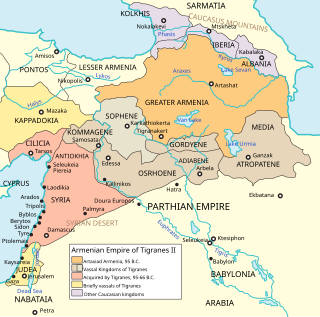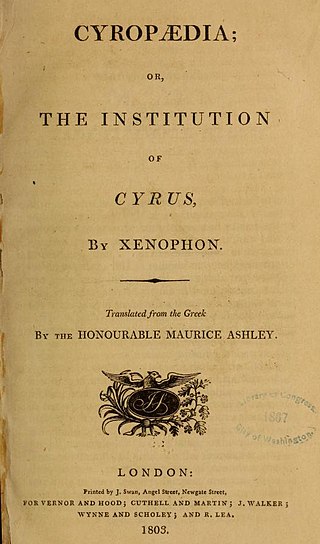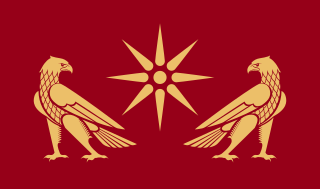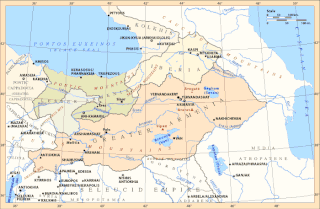
Orontes I Sakavakyats was a legendary king of Armenia, who was the personification of the Orontid dynasty.

Orontes I Sakavakyats was a legendary king of Armenia, who was the personification of the Orontid dynasty.
Orontes appears in both in the Cyropaedia of the Greek soldier and historian Xenophon (died 354 BC) and the History of Armenia of the 5th-century Armenian historian Movses Khorenatsi (died 490s AD). [1] In the Cyropaedia Orontes is unnamed, whilst in the History of Armenia he is given the name of Orontes. [2]
According to the Cyropaedia of Xenophon, the unnamed "king of Armenia" had agreed to provide troops and pay yearly tribute to the Median king Astyages after being defeated by him. When Media was invaded by the Chaldaeans during the reign of Astyages' son and successor Cyaxares, the "king of Armenia" refused to help to him as he was obliged. As a result, Cyrus, who was the son of Astyages' daughter Mandana, quickly led an expedition into Armenia. The "king of Armenia" sent his family, including his younger son Sabaris as well as the treasury to the mountains. They were, however, captured by the Persian commander Chrysantas. The Armenians panicked at the approach of Cyrus, who captured their "king". Tigranes, the elder son of the "king" and "who had been Cyrus' companion once on a hunt" returned from a journey abroad and convinced Cyrus to pardon the "king" and reinstall him. [3]
This account by Xenophon, which was not mentioned by Herodotus (died 425 BC), was considered "pure fabrication" by the Iranologist Alireza Shapur Shahbazi. Xenophon was known for creating ancient heroes by basing them on contemporary figures. [3] Tigranes was most likely based on the Persian hyparch Tigranes, who was the son-in-law of Struthas and lived in the same period as Xenophon. [4]
According to Shahbazi, the title of "king of Armenia" should not be taken seriously, as Xenophon also refers to the leader of Hyrcanians and satrap of Bactria as "kings". [5]
The History of Armenia of Movses Khorenatsi was composed to serve as a "national" history of Armenia from the era of the giants to Arsacid rule. According to the book, Eruand (Orontas/Aroandes/Orontes) "the Short-lived" was the father and predecessor of Tigranes. [6]
Scholarship has long agreed that the story is a mixture of history and various legends. Eruand "the Short-lived" was a personification of the Orontid dynasty, the predecessors of the Artaxiad dynasty, whose most distinguished ruler was Tigranes the Great (r. 95–55 BC). [7]
Tigranes is the Greek transliteration of the Old Iranian name *Tigrāna. This was the name of a number of historical figures, primarily kings of Armenia.

Armenia, also the Kingdom of Greater Armenia, or simply Greater Armenia or Armenia Major sometimes referred to as the Armenian Empire, was a kingdom in the Ancient Near East which existed from 331 BC to 428 AD. Its history is divided into the successive reigns of three royal dynasties: Orontid, Artaxiad and Arsacid (52–428).

The Cyropaedia, sometimes spelled Cyropedia, is a partly fictional biography of Cyrus the Great, the founder of Persia's Achaemenid Empire. It was written around 370 BC by Xenophon, the Athenian-born soldier, historian, and student of Socrates. The Latinized title Cyropaedia derives from the Greek Kúrou paideía, meaning "The Education of Cyrus". Aspects of it would become a model for medieval writers of the genre mirrors for princes. In turn, the Cyropaedia strongly influenced the most well-known but atypical of these, Machiavelli's The Prince, which fostered the rejection of medieval political thinking and development of modern politics.
Hydarnes, also known as Hydarnes the Elder, was a Persian nobleman, who was one of the seven conspirators who overthrew the Pseudo-Smerdis. His name is the Greek transliteration of the Old Persian name Vidṛna, which may have meant "he who knows the guilt/wrong".

Artaxias I was the founder of the Artaxiad dynasty of Armenia, ruling from 189 BC to 160 BC. Artaxias was a member of a branch of the Orontid dynasty, the earlier ruling dynasty of Armenia. He expanded his kingdom on all sides, consolidating the territory of Greater Armenia. He enacted a number of administrative reforms to order his expanded realm. He also founded a new capital in the central valley of the Araxes River called Artaxata (Artashat), which quickly grew into a major urban and commercial center. He was succeeded by his son Artavasdes I.

The Artaxiad dynasty ruled the Kingdom of Armenia from 189 BC until their overthrow by the Romans in 12 AD. Their realm included Greater Armenia, Sophene and intermittently Lesser Armenia and parts of Mesopotamia. Their main enemies were the Romans, the Seleucids and the Parthians, against whom the Armenians conducted multiple wars.
The Orontid dynasty, also known as the Eruandids or Eruandunis, ruled the Satrapy of Armenia until 330 BC and the Kingdom of Armenia from 321 BC to 200 BC. The Orontids ruled first as client kings or satraps of the Achaemenid Empire and after the collapse of the Achaemenid Empire established an independent kingdom. Later, a branch of the Orontids ruled as kings of Sophene and Commagene. They are the first of the three royal dynasties that successively ruled the antiquity-era Kingdom of Armenia.
Tiran known also as Tigranes VII, Tigranes or Diran was an Armenian prince who served as a Roman client king of Arsacid Armenia from 339 until 350. He was a contemporary of and is associated with the life of Sarkis the Warrior and his son, Martiros.

The Satrapy of Armenia, a region controlled by the Orontid dynasty, was one of the satrapies of the Achaemenid Empire in the 6th century BC that later became an independent kingdom. Its capitals were Tushpa and later Erebuni.
The origin of the Armenians is a topic concerned with the emergence of the Armenian people and the country called Armenia. The earliest universally accepted reference to the people and the country dates back to the 6th century BC Behistun Inscription, followed by several Greek fragments and books. The earliest known reference to a geopolitical entity where Armenians originated from is dated to the 13th century BC as Uruatri in Old Assyrian. Historians and Armenologists have speculated about the earlier origin of the Armenian people, but no consensus has been achieved as of yet. Genetic studies show that Armenian people are indigenous to historical Armenia, showing little to no signs of admixture since around the 13th century BC.
Cyaxares II was a king of the Medes whose reign is described by the Greek historian Xenophon. Some theories have equated this figure with the "Darius the Mede" named in the Book of Daniel. He is not mentioned in the histories of Herodotus or Ctesias, and many scholars doubt that he actually existed. The question of his existence impacts on whether the kingdom of the Medes merged peacefully with that of the Persians in about 537 BC, as narrated by Xenophon, or was subjugated in the rebellion of the Persians against Cyrus' grandfather in 559 BC, a date derived from Herodotus (1.214) and almost universally accepted by current scholarship.

The History of Armenia attributed to Movses Khorenatsi is an early account of Armenia, covering the legendary origins of the Armenian people as well as Armenia's interaction with Sassanid, Byzantine and Arsacid empires down to the 5th century.

Tigranes was a legendary Armenian prince, who was a contemporary of the Achaemenid ruler Cyrus the Great.

The Kingdom of Sophene, was a Hellenistic-era political entity situated between ancient Armenia and Syria. Ruled by the Orontid dynasty, the kingdom was culturally mixed with Greek, Armenian, Iranian, Syrian, Anatolian and Roman influences. Founded around the 3rd century BCE, the kingdom maintained independence until c. 95 BCE when the Artaxiad king Tigranes the Great conquered the territories as part of his empire. Sophene laid near medieval Kharput, which is present day Elazığ.

Armavir is a village in the Armavir Province of Armenia near the Armenia–Turkey border. Cuneiform inscriptions of Urartian King Sarduri II were found at Armavir.
Ancient Armenia refers to the history of Armenia during Antiquity. It follows Prehistoric Armenia and covers a period of approximately one thousand years, beginning at the end of the Iron Age with the events that led to the dissolution of the Kingdom of Urartu, and the emergence of the first geopolitical entity called Armenia in the 6th century BC. Highlights of this period include the rise of ancient Armenia as an important state in Western Asia in the 4th century BC; a briefly held empire under Julius Caesar's contemporary the Great King Tigranes II ; the kingdom's official conversion to Christianity in 301; and the creation of the Armenian alphabet in the year 405. It concludes with the demise of the Armenian kingdom and the country's partition later in the 5th century, marking the beginning of Medieval Armenia.
Azhdahak is the Armenian name of the Avestan demon Azhi Dahaka. In Iranian mythology, he is imprisoned in Mount Damavand, but will at the end of time break out, to be ultimately defeated by Fereydun. In his History of Armenia, the 5th-century Armenian writer Movses Khorenatsi identified Azhdahak with the Median king Astyages. Astyages' name was similar to that of Azhdahak, and the name Māda ("Mede") was pronounced in Armenian as Mār, which means snake in Iranian languages.

Armavir was a large commercial city and the capital of ancient Armenia during the reign of the Orontid dynasty. It is located 1 km west of the 17th-century village of Armavir.

Yervandashat or Eruandashat was an Armenian city and one of the historical capitals of Armenia, serving as the capital city between c. 200 BC and 176 BC under the rule of the Orontid dynasty and at the beginning of the rule of their successors, the Artaxiad dynasty. Its ruins are located on a rocky hill near the confluence of the Akhuryan and Aras rivers, on the left bank of the Aras, between the villages of Yervandashat and Bagaran in modern-day Armenia.